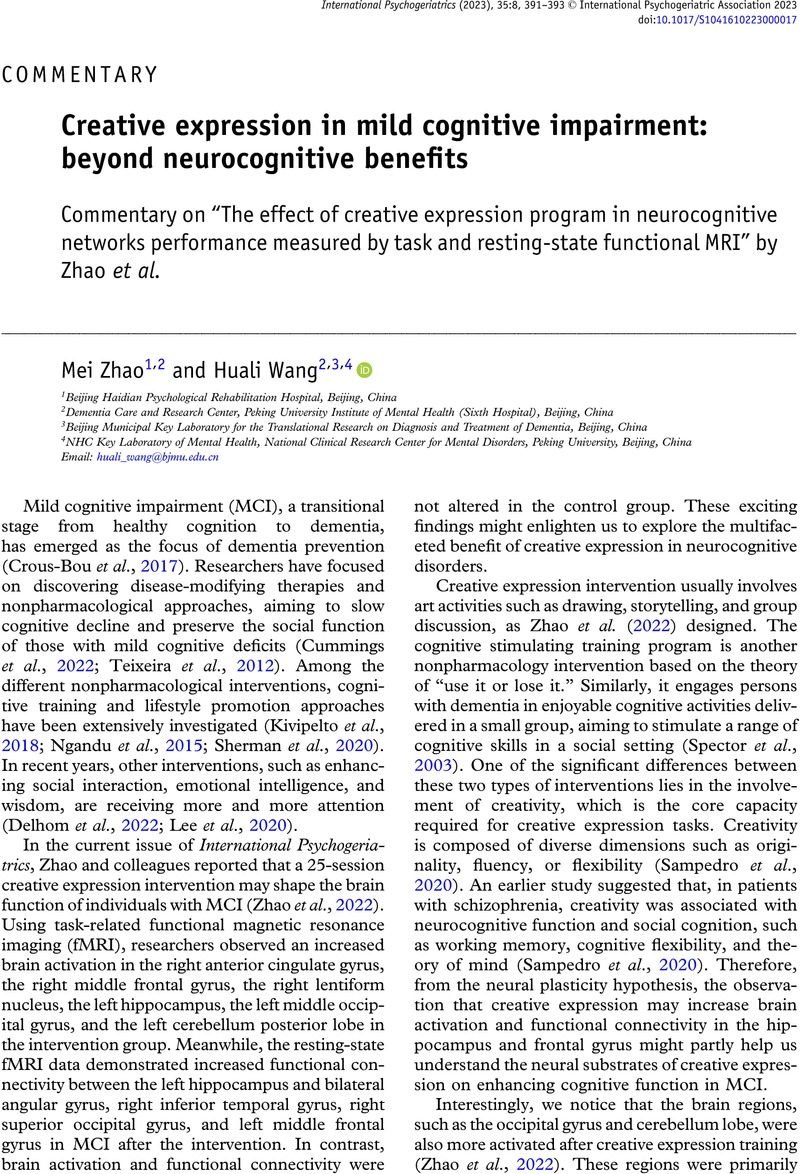No CrossRef data available.
Article contents
Creative expression in mild cognitive impairment: beyond neurocognitive benefits
Commentary on “The effect of creative expression program in neurocognitive networks performance measured by task and resting-state functional MRI” by Zhao et al.
Published online by Cambridge University Press: 18 January 2023
Abstract
An abstract is not available for this content so a preview has been provided. Please use the Get access link above for information on how to access this content.

- Type
- Commentary
- Information
- International Psychogeriatrics , Volume 35 , Special Issue 8: Issue Theme: Neurocognitive Markers Outside Dementia , August 2023 , pp. 391 - 393
- Copyright
- © International Psychogeriatric Association 2023
References
Creanza, N., Kolodny, O. and Feldman, M. W. (2017). Cultural evolutionary theory: how culture evolves and why it matters. Proceedings of the National Academy of Sciences, 114, 7782–7789. https://doi.org/10.1073/pnas.1620732114CrossRefGoogle ScholarPubMed
Crous-Bou, M., Minguillón, C., Gramunt, N. and Molinuevo, J. L. (2017). Alzheimer’s disease prevention: From risk factors to early intervention. Alzheimer’s Research & Therapy, 9, 71. https://doi.org/10.1186/s13195-017-0297-z
CrossRefGoogle ScholarPubMed
Cummings, J. et al. (2022). Alzheimer’s disease drug development pipeline: 2022. Alzheimer’s & Dementia: Translational Research & Clinical Interventions, 8, e12295. https://doi.org/10.1002/trc2.12295
Google ScholarPubMed
Delhom, I., Satorres, E. and Meléndez, J. C. (2022). Emotional intelligence intervention in older adults to improve adaptation and reduce negative mood. International Psychogeriatrics, 34, 79–89. https://doi.org/10.1017/S1041610220003579
CrossRefGoogle ScholarPubMed
Fritsch, T., Kwak, J., Grant, S., Lang, J., Montgomery, R. R. and Basting, A. D. (2009). Impact of TimeSlips, a creative expression intervention program, on nursing home residents with dementia and their caregivers. The Gerontologist, 49, 117–127. https://doi.org/10.1093/geront/gnp008
CrossRefGoogle ScholarPubMed
Glăveanu, V. P. (2015). Creativity as a sociocultural act. The Journal of Creative Behavior, 49, 165–180. https://doi.org/10.1002/jocb.94
CrossRefGoogle Scholar
Khona, M. and Fiete, I. R. (2022). Attractor and integrator networks in the brain. Nature Reviews Neuroscience, 23, 744–766. https://doi.org/10.1038/s41583-022-00642-0
CrossRefGoogle ScholarPubMed
Kivipelto, M., Mangialasche, F. and Ngandu, T. (2018).
Lifestyle interventions to prevent cognitive impairment, dementia and Alzheimer disease. Nature Reviews Neurology, 14, 653–666. https://doi.org/10.1038/s41582-018-0070-3
CrossRefGoogle ScholarPubMed
Lee, E. E. et al. (2020). Outcomes of randomized clinical trials of interventions to enhance social, emotional, and spiritual components of wisdom: a systematic review and meta-analysis. JAMA Psychiatry, 77, 925. https://doi.org/10.1001/jamapsychiatry.2020.0821
CrossRefGoogle Scholar
Ngandu, T. et al. (2015). A 2 year multidomain intervention of diet, exercise, cognitive training, and vascular risk monitoring versus control to prevent cognitive decline in at-risk elderly people (FINGER): a randomised controlled trial. The Lancet, 385, 2255–2263. https://doi.org/10.1016/S0140-6736(15)60461-5
CrossRefGoogle Scholar
Phillips, L. J., Reid-Arndt, S. A. and Pak, Y. (2010). Effects of a creative expression intervention on emotions, communication, and quality of life in persons with dementia. Nursing Research, 59, 417–425. https://doi.org/10.1097/NNR.0b013e3181faff52
CrossRefGoogle ScholarPubMed
Sampedro, A. et al. (2020). Neurocognitive, social cognitive, and clinical predictors of creativity in schizophrenia. Journal of Psychiatric Research, 129, 206–213. https://doi.org/10.1016/j.jpsychires.2020.06.019
CrossRefGoogle ScholarPubMed
Sherman, D. S., Durbin, K. A. and Ross, D. M. (2020). Meta-analysis of memory-focused training and multidomain interventions in mild cognitive impairment. Journal of Alzheimer’s Disease, 76, 399–421. https://doi.org/10.3233/JAD-200261
CrossRefGoogle ScholarPubMed
Sievers, B., Polansky, L., Casey, M. and Wheatley, T. (2013). Music and movement share a dynamic structure that supports universal expressions of emotion. Proceedings of the National Academy of Sciences, 110, 70–75. https://doi.org/10.1073/pnas.1209023110
CrossRefGoogle Scholar
Spector, A. et al. (2003). Efficacy of an evidence-based cognitive stimulation therapy programme for people with dementia: randomised controlled trial. British Journal of Psychiatry, 183, 248–254. https://doi.org/10.1192/bjp.183.3.248
CrossRefGoogle ScholarPubMed
Teixeira, C. V. L., Gobbi, L. T. B., Corazza, D. I., Stella, F., Costa, J. L. R. and Gobbi, S. (2012). Non-pharmacological interventions on cognitive functions in older people with mild cognitive impairment (MCI). Archives of Gerontology and Geriatrics, 54, 175–180. https://doi.org/10.1016/j.archger.2011.02.014
CrossRefGoogle ScholarPubMed
Xiong, R. M. et al. (2022). The pattern of cortical thickness underlying disruptive behaviors in Alzheimer’s disease. Psychoradiology, 2, 113–120. https://doi.org/10.1093/psyrad/kkac017
CrossRefGoogle Scholar
Yang, Z., Li, L., Peng, Y., Qin, Y. and Li, M. (2022). The pyramid representation of the functional network using resting-state fMRI. Psychoradiology, 2, 100–112. https://doi.org/10.1093/psyrad/kkac011
CrossRefGoogle Scholar
Zhao, J., Cai, W., Su, J., Lin, R., Ma, M. and Li, H. (2022). The effect of creative expression program in neurocognitive networks performance measured by task and resting-state functional MRI. International Psychogeriatrics, 35, 411–420. https://doi.org/10.1017/S1041610222000382
Google Scholar




